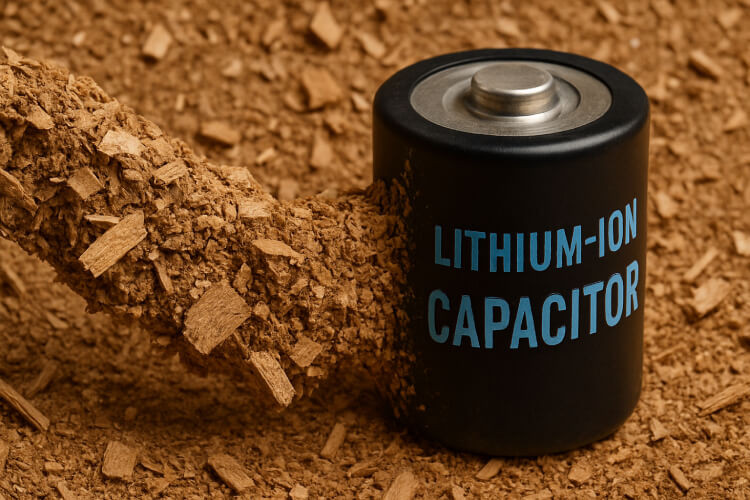Battery Electrodes From Wood Show High-Capacity Potential
Insights | 14-05-2025 | By Robin Mitchell

Key Takeaways:
- Forestry waste powers innovation: Researchers in Spain developed a lithium-ion capacitor using electrodes derived from sawmill wood waste, reducing environmental impact and material costs.
- High performance, low degradation: The device delivers 105 Wh/kg at 700 W/kg and retains 60% capacity after 10,000 cycles—surpassing many traditional lithium-ion batteries.
- Carbon-efficient manufacturing: Electrode production avoids high-temperature synthesis and chemical additives, cutting energy input and emissions.
- Scalable for mobility and energy grids: Designed for rapid charge-discharge cycles, the technology suits electric vehicles and renewable energy systems requiring power stability.
As the global demand for energy storage rises, driven by electric vehicles, portable electronics, and renewable energy systems, so does the pressure to reduce the environmental toll of traditional battery technologies. While lithium-ion batteries remain the industry standard, their production and disposal come at a significant ecological cost, from toxic chemical use to the depletion of finite resources.
In response, researchers are exploring innovative materials that combine performance with sustainability. One particularly promising development comes from the University of Basque Country, where scientists have created battery electrodes using waste wood particles. Could this biomass-based approach redefine how we store energy? And what does this mean for the future of eco-conscious electronics and energy systems?
The Environmental Impact of Battery Technologies
The history of battery development dates back to the early 19th-century invention of the Daniell cell by John Frederic Daniell. This innovation marked a significant improvement over earlier battery designs, which were often plagued by issues such as safety and reliability. The Daniell cell, which utilised a copper pot and zinc plate in a sulfuric acid solution, paved the way for the development of more advanced battery technologies. Throughout the 20th century, researchers continued to explore new materials and designs, leading to the creation of a wide range of battery types, including lead-acid, nickel-cadmium, and lithium-ion.
Despite the numerous advancements in battery technology, the environmental implications of battery production have long been a concern. The early days of battery manufacturing were characterised by a lack of environmental regulations and a focus on rapid production, often at the expense of sustainability. The use of toxic chemicals, such as lead and cadmium, in battery production processes posed significant risks to both human health and the environment. The release of these harmful substances into the air and water led to widespread pollution, affecting not only the surrounding ecosystems but also the communities living near battery production facilities.
From Innovation to Environmental Risk
As the industry continued to evolve, the focus shifted towards the development of more sustainable battery materials. Researchers began to explore alternative options, such as lithium and cobalt, which offered improved performance and energy density. However, the extraction of these materials has raised concerns about the environmental impact of mining activities. The destruction of natural habitats and ecosystems, as well as the displacement of local communities, have become major issues in the pursuit of sustainable battery technologies.
The toxicity of chemicals used in battery production is another significant environmental challenge facing the industry. The use of heavy metals and electrolytes in battery manufacturing processes poses serious health risks to both humans and the environment. The inhalation of toxic fumes and the leaching of harmful compounds into the water supply have become major concerns in the battery manufacturing sector. The long-term ecological consequences, including the contamination of soil and water sources, can have devastating effects on ecosystems and human health.
In addition to the toxicity of chemicals used in production, the disposal of batteries also poses significant environmental risks. The improper disposal of batteries can lead to the leakage of harmful compounds into the environment, contaminating soil and water sources. The accumulation of toxic waste in landfills can have serious consequences for ecosystems and human health, emphasising the need for sustainable battery disposal practices.
Recycling batteries presents a significant challenge for the industry, with technical and economic difficulties hindering effective recycling processes. The limited infrastructure and technology available for battery recycling make it a complex issue, with the potential for environmental degradation and human health risks if not handled properly.
Researchers Create Battery Electrodes From Wood
Researchers at the University of Basque Country have developed a new hybrid supercapacitor that stores high amounts of energy while retaining its performance over thousands of cycles. The device, which is a lithium-ion capacitor, utilises electrodes made from sawmill wood waste particles to store energy. The use of biomass-derived materials in the electrodes makes the device more sustainable and cost-effective compared to traditional lithium-ion batteries.
Unlike conventional battery electrodes, which often involve high-temperature synthesis or costly chemical doping, the researchers limited all processing temperatures to 700 °C and avoided the use of expensive additives. This strategic simplification reduces energy input and supports a lower-carbon manufacturing profile, positioning the technology as a cleaner alternative within the lithium-ion capacitor space.
Minimising Environmental Impact Through Local Biomass
This approach leverages the local availability of Pinus Radiata wood waste in the Basque region, minimising transportation emissions and reducing reliance on critical raw materials such as graphite, which faces growing supply risks due to its classification as a critical raw material within the EU.
According to the researchers, the new device can store 105 Wh/kg at a power density of 700 W/kg. In addition to its high energy storage capacity, the device also retains 60% of its capacity after 10,00 charge cycles, which is significantly better than traditional lithium-ion batteries that degrade over time. The device is also able to charge and discharge quickly, making it ideal for high-power applications such as electric vehicles and renewable energy systems.
Performance testing showed the device retained over 60% of its initial capacity even after 10,000 cycles at 10C, with discharge durations suitable for bridging short-duration energy gaps in fast-charge/discharge scenarios. This level of durability aligns well with demands in electromobility and grid-balancing use cases.
Sustainable Electrode Design and Local Material Sourcing
The researchers developed the device using a combination of biomass-derived materials and sustainable processes. The electrodes were made from carbon derived from Pinus Radiata wood waste, which is an abundant and inexpensive resource in the Basque Country region of Spain. The use of biomass materials in the electrodes eliminates the need for expensive chemicals and energy-intensive processes, making the device more cost-effective and environmentally friendly.
The activated carbon used for the positive electrode exhibited a high specific surface area of 2399 m²/g, facilitating rapid ion exchange and enhanced energy storage capacity. This was achieved through potassium hydroxide activation—a widely validated and low-cost chemical activation method in carbon material science.
The new device has the potential to replace traditional lithium-ion batteries in various applications, including electric vehicles and renewable energy storage systems. The use of biomass-based materials in the device also makes it a more sustainable option compared to traditional lithium-ion capacitors. While the device is still in the experimental stage, it has shown promising results in terms of energy storage capacity and cycle life, making it a potential candidate for future energy storage applications.
In comparative testing, two full-cell configurations were evaluated—1:1 and 1:2 mass ratios of hard carbon to activated carbon. The optimised 1:1 configuration not only achieved 111 Wh/kg at 51 W/kg but also demonstrated superior capacity retention and voltage stability, avoiding issues like lithium plating that may compromise long-term safety and performance.
Going Into The Future
The need for more sustainable battery technologies is becoming increasingly important as the demand for renewable energy sources continues to grow. The widespread adoption of electric vehicles and renewable energy sources is putting a strain on traditional battery technologies, which have been shown to have significant environmental impacts. However, by utilising waste biomass materials, such as wood and plant fibres, researchers are starting to create electrodes that are not only more sustainable but also cost-effective.
The use of biomass-derived electrodes also presents tremendous opportunities, especially for recycling. Traditional lithium-ion batteries are notoriously difficult to recycle, with many being sent to landfills where they can leak toxic chemicals into the environment. In contrast, biomass-derived electrodes can be easily recycled, with the biomass materials being returned to the earth for use in growing new plants. This not only reduces the environmental impact of battery disposal but also helps to create a closed-loop system where materials can be continually recycled.
From a lifecycle perspective, the dual-carbon structure enables more straightforward disassembly and material recovery. Hard carbon electrodes sourced from waste wood present lower toxicity risks and fewer processing residues compared to synthetic graphite or metal-based counterparts.
Overall, the development of sustainable battery technologies is a critical step in reducing the environmental impact associated with battery use. As researchers continue to explore new technologies, the need for efficient recycling methods will also grow in importance. By working together to develop new sustainable battery solutions, we can create a more environmentally friendly future for generations to come.

